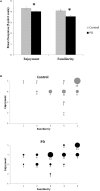Music to One's Ears: Familiarity and Music Engagement in People With Parkinson's Disease
- PMID: 31293379
- PMCID: PMC6603171
- DOI: 10.3389/fnins.2019.00661
Music to One's Ears: Familiarity and Music Engagement in People With Parkinson's Disease
Abstract
Parkinson's disease (PD) is a complex diagnosis commonly associated with motor dysfunction, but known to comprise cognitive, psychiatric, and mood disturbances as well. Music has been successfully used to address motor and non-motor symptoms of PD. Still, little is known about the nature of an individual with PD's experience and relationship with music on conceptual and emotional levels, which may factor into their engagement in music-based techniques to ameliorate impairments. Two surveys were administered to 19 individuals with PD and 15 individuals without PD in order to gauge their subjective impressions and valuations of music. Participants completed The Brief Music Experience Questionnaire (BMEQ), a standard self-report measure pertaining to the role of music in one's life, prior to performing a perception task which involved listening to and making sound adjustments to three music recordings. Following the perception task, a custom Exit Survey was administered to evaluate the experience of listening to and engaging with the music in the perception task. In all six dimensions of the BMEQ, examining aspects of music experience including commitment to music, self-reported musical aptitude, social uplift, affective reactions, positive psychotropic effects, and reactive musical behavior (RMB, pertaining to actions or behaviors in response to music), the mean and the median were greater for the control group than for the PD group, but the difference was only statistically significant in the RMB dimension. On the Exit Survey, both groups assessed recent, specific, and interactive music listening more positively than the imagined, hypothetical or general music experiences addressed on the BMEQ. Additionally, familiarity had a greater effect on listening pleasure for participants with PD than those without PD. We conclude that people with PD may perceive less of an automatic connection between music and activity than their healthy peers. Additionally, they may receive more pleasure and value from music than they anticipate. Taken together, our results suggest that people with PD may require encouragement to participate as well as empowerment to choose familiar selections in order to better access music-based interventions and the benefits they can offer.
Keywords: Brief Music Experience Questionnaire; Parkinson’s disease therapy; Rhythmic Auditory Stimulation; neurologic music therapy; neuromusic.
Figures


Similar articles
-
Musical pleasure beneficially alters stride and arm swing amplitude during rhythmically-cued walking in people with Parkinson's disease.Hum Mov Sci. 2020 Dec;74:102718. doi: 10.1016/j.humov.2020.102718. Epub 2020 Nov 21. Hum Mov Sci. 2020. PMID: 33232856
-
Familiarity with music influences stride amplitude and variability during rhythmically-cued walking in individuals with Parkinson's disease.Gait Posture. 2021 Jun;87:101-109. doi: 10.1016/j.gaitpost.2021.04.028. Epub 2021 Apr 21. Gait Posture. 2021. PMID: 33895635
-
Decomposing the Effects of Familiarity with Music Cues on Stride Length and Variability in Persons with Parkinson's Disease: On the Role of Covariates.Int J Environ Res Public Health. 2022 Aug 30;19(17):10793. doi: 10.3390/ijerph191710793. Int J Environ Res Public Health. 2022. PMID: 36078509 Free PMC article.
-
Musical pleasure and reward: mechanisms and dysfunction.Ann N Y Acad Sci. 2015 Mar;1337:202-11. doi: 10.1111/nyas.12677. Ann N Y Acad Sci. 2015. PMID: 25773636 Review.
-
Music enjoyment with cochlear implantation.Auris Nasus Larynx. 2018 Oct;45(5):895-902. doi: 10.1016/j.anl.2017.11.008. Auris Nasus Larynx. 2018. PMID: 29519690 Review.
Cited by
-
An Overview of Acoustic-Based Interventions to Improve Motor Symptoms in Parkinson's Disease.Front Aging Neurosci. 2020 Aug 14;12:243. doi: 10.3389/fnagi.2020.00243. eCollection 2020. Front Aging Neurosci. 2020. PMID: 32922283 Free PMC article. Review.
-
Music as Add-On Therapy in the Rehabilitation Program of Parkinson's Disease Patients-A Romanian Pilot Study.Brain Sci. 2021 Apr 29;11(5):569. doi: 10.3390/brainsci11050569. Brain Sci. 2021. PMID: 33946687 Free PMC article.
-
Music Therapy and Parkinson's Disease: A Systematic Review from 2015-2020.Int J Environ Res Public Health. 2021 Nov 4;18(21):11618. doi: 10.3390/ijerph182111618. Int J Environ Res Public Health. 2021. PMID: 34770129 Free PMC article.
-
Construction of a Chinese traditional instrumental music dataset: A validated set of naturalistic affective music excerpts.Behav Res Methods. 2024 Apr;56(4):3757-3778. doi: 10.3758/s13428-024-02411-6. Epub 2024 May 3. Behav Res Methods. 2024. PMID: 38702502 Free PMC article.
References
LinkOut - more resources
Full Text Sources
Medical
Miscellaneous

